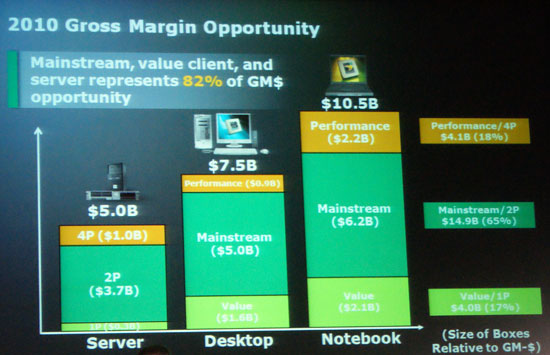The RV770 Story: Documenting ATI's Road to Success
by Anand Lal Shimpi on December 2, 2008 12:00 AM EST- Posted in
- GPUs
Building a GPU for the Masses
AMD put up this graph at its recent Financial Analyst Day:

The performance segment of the desktop CPU market is only about 7% of the pie and although it generates a disproportionately large amount of revenue it’s neither the biggest segment nor the biggest revenue generator in the market. That would be the mainstream segment.
ATI realized much of the same thing back in 2005. These high end GPUs were getting more and more expensive, while R300 tipped the scales at $399 over the coming years we’d see GPUs hit $499, $599 and go north of $600 at launch. The higher prices were due to increasing die sizes and techniques such as harvesting, ensuring that regardless of how big the GPU, revenues were protected.
A $399 R300 was close enough to the mainstream price points that ATI was able to scale it down months later to address other markets, but these days the time between the high end GPU introduction and the mainstream revisions of it has increased to 6 - 9 months. We still don’t have a mainstream derivative of NVIDIA’s GT200 architecture and chances are that we won’t until around 9 months after its introduction. With the GeForce GTX 280 launching at $600, for it to take 9 months to make a $200 derivative is doing the market a disservice in ATI’s eyes.
It was time to refocus. Instead of tailoring to the needs of the high end, ATI wanted to make a product that would be the best in the $200 - $300 range. To do so would mean that it would have to reverse the strategy that made it successful to begin with, and hope that somehow NVIDIA wouldn’t follow suit.










116 Comments
View All Comments
Spivonious - Wednesday, December 3, 2008 - link
I totally agree! Articles like this one are what separates Anandtech from the multitude of other tech websites.goinginstyle - Wednesday, December 3, 2008 - link
I have to admit this is one of the best articles I have read anywhere on the web in a long time. It is very insightful, interesting, and even compelling at times. Can you do a follow up, only from an NVIDIA perspective.Jorgisven - Wednesday, December 3, 2008 - link
I totally agree. This article is superbly written. One of the best tech articles I've read in a long long time, out of any source, magazine or online. I highly doubt nVidia will be as willing to expose their faults as easily as ATI was to expose their success; but I could be entirely mistaken on that.In either case, well done Anand. And well done ATI! Snagged the HD4850 two days after release during the 25% off Visiontek blunder from Best Buy during release week. I've been happy with it since and can still kick around the 8800GT performance like yesterday's news.
JonnyDough - Wednesday, December 3, 2008 - link
I agree about the insight especially. Gave us a real look at the decision making behind the chips.This got me excited about graphics again, and it leaves me eager to see what will happen in the coming years. This kind of article is what will draw readers back. Thank you Anandtech and the red team for this amazing back stage pass.
magreen - Wednesday, December 3, 2008 - link
Great article! Really compelling story, too.Thanks AMD/ATI for making this possible!
And thanks Anand for continually being the best on the web.
JPForums - Wednesday, December 3, 2008 - link
Like others have said, this is probably the best article I've read in recent memory. It was IMHO well written and interesting. Kudos to ATI as well for divulging the information.I second the notion that similar articles from nVidia and Intel would also be interesting. Any chance of AMD's CPU division doing something similar? I always find the architectural articles interesting, but they gain more significance when you understand the reasoning behind the design.
jordanclock - Wednesday, December 3, 2008 - link
This is easily one of my favorite articles on this website. It really puts a lot of aspects of the GPU design process into perspective, such as the shear amount of time it takes to design one.I also think this article really adds a great deal of humanity to GPU design. The designers of these marvels of technology are often forgotten (if ever known by most) and to hear the story of one of the most successful architectures to date, from the people that fought for this radical departure... It's amazing, to say the least.
I really envy you, Anand. You get to meet the geek world's superheroes.
pattycake0147 - Wednesday, December 3, 2008 - link
I couldn't agree more! This could be the best article I've read here at anandtech period. The performance reviews are great, but once in a while you need something different or refreshing and this is just precisely that.LordanSS - Wednesday, December 3, 2008 - link
Yep, I agree with that. This is simply one of the best articles I've read here.Awesome work, Anand.
Clauzii - Wednesday, December 3, 2008 - link
I totally agree.